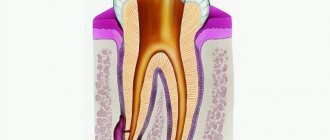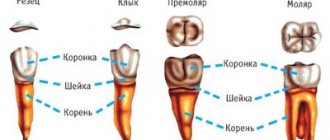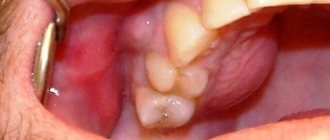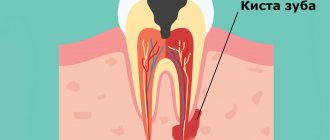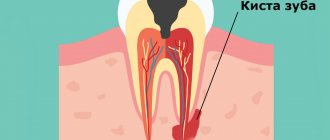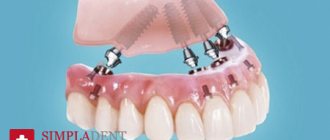The Greek word "kystis", used to refer to a condition such as a dental cyst, is translated as "blister". This name most accurately reflects the essence of this disease. With it, a cavity is formed at the root of the tooth, which is filled with liquid (bacteria and dead cells), and the comparison with a bubble in this case is most appropriate.
The consequences of untimely treatment of a cyst in the gum of a tooth can be the most unpleasant - including tooth loss. The process may also involve neighboring teeth, which will also require professional dental treatment.
Resection of the root apex (frontal group) - 6,500 rubles.
Resection of the root apex (chewing group) - RUB 9,000.
At CELT you can get advice from a dental specialist.
- The cost of a dental consultation is 1,000
- The cost of an orthodontist consultation is 2,000
Make an appointment
Cyst symptoms
In the initial stages, the cyst is almost invisible. Unlike an abscess, it does not break out, but at the same time continues its development inside, affects healthy tissue of the jaw bone and leads to loosening of the tooth. As the inflammatory process develops, the following symptoms of a cyst in the tooth appear:
- pain in the affected area;
- swelling of the gums;
- increased body temperature;
- swollen and tender lymph nodes;
- flux.
The pathology quickly develops into a chronic stage and is asymptomatic for humans. During an exacerbation, attacks of pain may occur when eating solid foods. Gradually, the tooth enamel becomes gray or yellow, and the tooth shifts. As soon as the immune system fails due to acute respiratory viral infections or exacerbation of chronic diseases, the growth of the cyst accelerates, so the appearance of a fistula, swelling, acute pain, fever and migraine is observed.
Indications
- Bite abnormalities.
- Periodontitis.
- Installation of orthodontic systems.
- Severe deformation of the ligamentous apparatus (tooth loosening).
- Hyperdontia.
Contraindications
- ARVI and weak immunity.
- Chronic and acute forms of diseases of the cardiovascular system.
- Nervous and mental disorders.
- Cancerous tumors.
Aspiration (pumping out the purulent contents of the cyst)
Next, it is important to evacuate the purulent contents from the festering cyst cavity as thoroughly as possible. For the doctor and the patient, purulent contents are an excellent way to diagnose a cyst, since there are many known cases of more serious neoplasms being disguised under the symptoms of cysts. The absence of purulent contents most likely indicates an erroneous preliminary diagnosis and is an indication for further examination of the patient for neoplasms masquerading as a cyst. The absence of pus or cystic fluid may indicate the presence of fibrous or other solid cell formation. Interventions should never be carried out in the area of a large radiographically detectable lesion without first removing purulent fluid from it.
Why does a cyst appear?
The causes of the appearance of a dental cyst, a photo of which can be seen in this article, are injuries due to mechanical stress or infection, which leads to the development of inflammation of the tissues surrounding the tooth. A tooth inside the gum can be injured under a variety of circumstances, for example, when the tooth is hit or when chewing nuts. As for infection, it can get into the root canal if dental treatment is performed incorrectly, in particular, if the dental canal is incompletely filled. A cyst that arose as a result of sinusitis or another infectious disease is relatively rare. In this case, pathogenic microorganisms enter the gums along with the blood flow.
When are antibiotics needed for dental implants?
Modern research proves that one of the reasons for the development of peri-implantitis1 is a violation of the microflora of the oral cavity. That is, there are many “bad” bacteria compared to the good ones - these are anaerobic bacilli, streptococci and other cocci. In addition, unprofessional installation of implants or the choice of incorrect designs plays a big role. For example, during installation, a doctor may allow implants, which are in sterile packaging, to come into contact with the patient’s lips or tongue, that is, with saliva, where many pathogenic bacteria live.
If we are talking about the engraftment stage, then with insufficient oral hygiene on the part of the patient, in the presence of general problems with the body (especially viral and bacterial infections of the oral cavity or nose, including in a chronic compensated form), there is also a high risk of developing inflammatory processes.
Indications for antibiotic therapy:
- poor initial oral hygiene,
- difficult care of implants and crowns after their installation,
- one-stage implantation, in which prostheses are installed immediately,
- installation of implants against the background of periodontitis, periodontal disease or osteomyelitis,
- implantation of implants simultaneously with removal of tooth roots,
- multiple installation of implants,
- chronic diseases of the nasopharynx,
- reduced immune status of the patient,
- bone tissue augmentation surgery combined with implantation.
The effectiveness of antibiotics in dental implantation
In practice, it has been proven that patients who do not take antibiotics at any stage of implantation are at a “high” risk of developing inflammatory processes in the oral cavity. And even in patients whose oral cavity maintains a “normal” balance of microflora, there is a risk of complications after surgery, because literally every little thing influences a favorable outcome: the state of health of the entire oral cavity, the professionalism and conscientiousness of the attending physician, the model of the implant used.
“We make sure to prescribe patients not only antibiotics, but also painkillers and antihistamines. They are taken in combination to relieve swelling, reduce inflammation, and speed up the rehabilitation of the body as a whole. We very often carry out complex dental restoration against the background of inflammatory processes of periodontal tissue, so antibiotic therapy is among the mandatory procedures after dental implantation.”
Bespalov Roman Dmitrievich, maxillofacial surgeon, implantologist, work experience of more than 26 years make an appointment
Two-piece implants for delayed loading with a prosthesis usually have a porous coating. On the one hand, it ensures better osseointegration of the structure in the bone tissue. On the other hand, it is the rough outer surface that is the site of accumulation of bacteria, which leads to the development of peri-implantitis. In most situations, this is relevant after the implants have been implanted, since over time the bone tissue sags a little (this is a physiological process that is considered normal) and the top of the implant becomes exposed. But in the first months after installation, bacteria can also accumulate on implants. For example, if the structure is located slightly above the gum (due to incorrect installation or incorrect choice of model), as well as if the implant-abutment connection is not tight.
A low risk of developing inflammation of periodontal tissue while taking antibiotics occurs in the following cases:
- when choosing two-piece implants with an antimicrobial coating in the apex and when using abutments with a similar smooth antimicrobial coating,
- when choosing implantation methods that use one-piece one-piece implants with a smooth body or a neck that remains above the gum. In addition, such implants are fixed in deeper parts of the bone, which are not subject to inflammatory processes, so the risk of peri-implantitis (especially when taking antibiotics) is noticeably reduced.
How does the disease develop?
The process begins with periodontitis, when the tissue located between the jaw bone and the tooth root becomes inflamed. As a result, the tissues located around the root begin to grow abnormally. Initially, the size of the neoplasm does not exceed five millimeters (it is called a granuloma). Growing and enlarging, it becomes covered with a membrane and transforms into a cyst.
There are cases when the cyst grows so much that it eats away the bone around the tooth. With the next exacerbation of inflammation, it opens, forming a channel to the outside through the gum mucosa. Such a channel is called a fistula or fistula tract.
It is worth noting once again the insidiousness of this disease, which not only negatively affects the condition of the roots of the teeth, but also affects the general condition of a person. At the initial stage, the pathology develops almost imperceptibly and can only be detected during a visit to the dentist. Pronounced symptoms appear in the later stages of the disease as a result of tumor growth and destruction of bone tissue.
The main danger of a cyst is the fact that, by corroding the bone, it deprives the patient of the opportunity to install an implant in place of a lost tooth without complex manipulations.
What complications does a dental cyst lead to?
Untimely treatment or removal will lead to the following complications:
- Periostitis.
- Swelling.
- Abscess.
- Phlegmon.
- Temperature increase.
Usually the cyst does not make itself felt in any way, so complications may appear unexpectedly. To exclude serious consequences, you need to be examined by a dentist at least once every six months. The appearance of a capsule with pus can occur against the background of deep caries or severe inflammation of the gums, so do not delay a visit to a specialist.
The lack of results with conservative treatment leads to the fact that the cyst has to be removed along with the tooth.
Why is a cyst dangerous and why should you never delay its treatment?
Many people are so afraid of dentists that they do not seek treatment for cysts until the last minute, even when the disease develops pronounced symptoms. If you suspect that you have a dental cyst, but delay treatment, you are seriously risking your health, because a cyst is a dangerous disease that can cause severe complications.
Lack of treatment for a dental cyst can lead to:
- To the development of sinusitis if the tooth is located in close proximity to the maxillary sinuses;
- Inflammatory processes in the periosteum - flux, periostitis;
- Provoke an abscess, phlegmon, osteomyelitis.
If an infection from a cyst gets into the soft tissue, it can cause a life-threatening condition such as sepsis. Therefore, do not delay or put off cyst treatment until later. There is no need to be afraid that it will be painful: before the doctor begins to remove the tumor, he will definitely numb the tooth. Patients of our clinic in Moscow “Firadent” can take advantage of a special service - treatment of dental cysts under sedation.
Types of dental cyst
The type depends on the place of occurrence. A cyst forms in the maxillary sinus, gum, root or under the crown. To determine the type of capsule with pus, the specialist examines the medical history and assesses the client’s general health. There are 5 types of dental cysts:
- Follicular - formed when the tooth was unable to grow unhindered and most of it remained inside.
- Keratocyst - develops against the background of pathological processes during the growth of the body (the growth of the neoplasm is stimulated by the pharynx-forming tissue).
- Radicular - appears from a granuloma and is a serious complication of deep caries.
- Retention – is formed during the eruption of molars in children.
- Residual – appears due to complications and inflammatory processes after tooth extraction.
Cyst in the inflammatory stage
Since usually an exacerbation of a cyst rarely goes away without pain, it is recommended that the cyst opening procedure be carried out under combined anesthesia. At this stage, preliminary conservative treatment with loading doses of antibiotics is already useless. Of course, classical conduction anesthesia is the ideal method of pain relief for this manipulation, but we carry it out with the help of combined techniques. This is either a cocktail taken orally 10 minutes before the procedure, or combination drugs that enhance each other’s analgesic effects. This combination allows you to obtain the optimal degree of pain relief. If there is a financial opportunity, then the best type of pain relief when treating a cyst in the stage of active inflammation is still sedation. Another name for this procedure is sleep therapy. Since sedation is carried out with propofol, an ultra-short hypnotic effect is formed without narcotics and anesthesia.
Cyst on the root of a tooth
This species grows in the alveolar area and can appear in any area of the gum. There are no symptoms except for tingling when eating or touching. Pain appears in later stages of development. A cyst on the root of a tooth is divided into 3 types:
- Peri-root - appears in the upper part of the root.
- Interroot – formed between the roots.
- Radical - appears near the root canal and over time can cause the growth of a malignant tumor of the jaw (if not properly treated).
Removal of a cyst without tooth extraction: surgical treatment methods
If the diagnosis shows that the cyst has managed to grow to a significant size or the patient turns to the dentist in the later stages of development of the formation, an operation to remove the cyst is prescribed. There is no need to worry: in most cases, it is possible to remove the cyst, but at the same time save the tooth; sometimes, along with the cyst, one of the roots of the tooth is removed - completely or partially.
There are several methods for surgical removal of a cyst: the specific technology is selected individually for the patient, taking into account the characteristics of the clinical case. We will analyze all the surgical methods for removing a cyst and find out when and what method is used.
Hemisection for removal of a dental cyst
This surgical method for treating a cyst involves removing the purulent capsule itself, as well as part of the tooth root and its crown. Hemisection is recognized as a complex method of cyst removal and is performed when it is impossible to use other treatment methods. Hemisection is applicable only for teeth that have several roots, and since after it the tooth partially loses its chewing functions, it will need to be restored not with a filling, but with a crown.
Removal of a cyst using cystectomy
This cyst removal technique is used most often. It is considered the most gentle method of surgical removal of a cyst, but requires experience, qualifications and care from the doctor. When performing a cystectomy, treatment begins with canal treatment, after which an incision is made in the gum next to the diseased tooth, and the dentist removes the cyst along with part of the tooth root.
Cystotomy to remove the cyst
The operation is considered simple for the doctor and minimally traumatic for patients, but it has a disadvantage - after cystotomy, when removing the cyst, the tissue takes quite a long time to recover.
The essence of the technique is to remove the anterior wall of the cyst through an incision in the gum and pump out the pus that has accumulated in the capsule. Cystotomy to remove the cyst is performed when the tumor is large, as well as in cases where the cyst is formed at the base of the jaw and the bone tissue is very thin.
Separately, it is worth mentioning the treatment of dental cysts with laser. This technique is considered an innovation, as it began to be used for the treatment of cysts in Moscow dentistry relatively recently. Laser removal of a dental cyst is carried out in several stages:
- The tooth is drilled out so that the doctor has full access to its canals;
- The cyst is removed with a laser;
- The canal cavities are disinfected with laser radiation;
- The canals are filled, the tooth is restored with a filling.
Laser removal of a dental cyst has many advantages, including painless surgery, fast tissue restoration, and the ability to save the tooth. However, there are also disadvantages: the price of laser cyst removal is high, the cost of the operation will be higher than the price of cyst removal by other methods.
Conservative and surgical treatment of cysts
In the early stages, in the absence of complications, a conservative method is acceptable. The root canal is drilled and cleaned. The capsule with pus is opened and cleaned, and a composition with an antibiotic is poured inside. Next, a bone tissue regeneration paste is applied and a filling is installed. A control check after 6 months demonstrates the absence of a cyst on an x-ray in 80% of cases
Surgical treatment is prescribed if there is no result. With the help of cystectomy, the affected part of the tooth and the capsule with pus are completely removed. Cystectomy is an operation that not all dental surgeons can do. Hemisection is often used, which gives a 100% result and is prescribed for severe root damage. All affected tissue is removed, and the appearance of the tooth is restored with a crown or composite composition.
